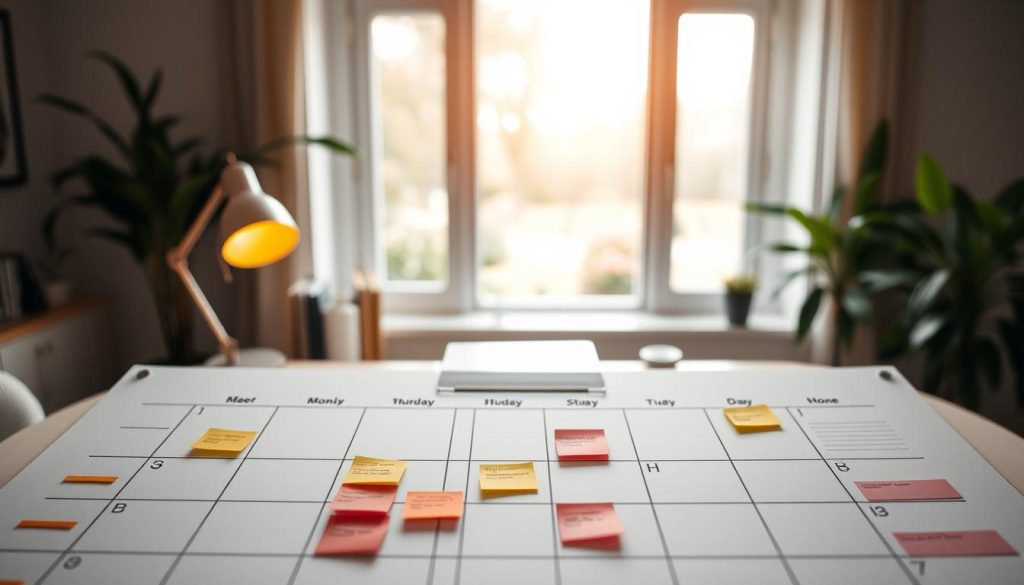Working solo can feel rewarding and chaotic at once. Many independent workers face unique pressures and a higher risk of burnout than office staff. Research shows 77% of American workers have felt burned out, so practical habits matter.
Small, repeatable routines—like a dedicated workspace and a simple schedule—help protect time and improve results. Time blocking, batching meetings, and weekly planning cut decision fatigue and keep your day focused.
We’ll map out clear strategies to turn flexibility into a reliable schedule so a freelancer can stop firefighting and make steady progress each day. Expect friendly, actionable advice that fits a France-based lifestyle, from outdoor breaks to cycling paths.
For evidence-backed organisation tips, see this guide on efficient work routines: effective work organisation for independents.
Table of Contents
Key Takeaways
- Designate a workspace and keep a disciplined schedule to protect your time.
- Use time blocking and batching to reduce decision fatigue and context switching.
- Adopt a morning cue, deep-focus blocks, and an end-of-day ritual for a steady routine.
- Build prevention as a repeatable process to stave off burnout.
- Make small, consistent changes for compounding gains in productivity and life balance.
Why stress hits freelancers differently in today’s world
In today’s world, working alone often means juggling sales, delivery, and admin — and that juggling raises the baseline of daily pressure.
Surveys show 43% of independent workers feel fatigue from long workdays and 64% report poor work-life balance. Income swings, isolation, and shifting roles make these numbers worse.
Unique stressors: income swings, isolation, and shifting roles
Unstable income and stacked jobs push people to accept tight deadlines and last-minute edits. That wears down energy and speeds burnout.
- One person covers pipeline, pricing, and delivery, so the day stretches across more hours.
- Working from home can increase isolation and hurt mental health without regular support.
- Client expectations often expand when availability seems unlimited, blurring home and work time.
What “flexibility” really costs without structure
Flexibility is valuable, but without clear start and stop times it often becomes every-hour availability. That slowly erodes life outside the job.
« Flexibility without boundaries turns free time into extra work hours. »
| Stressor | Typical effect | Quick fix |
|---|---|---|
| Income volatility | Pressure to take more jobs | Set minimum rates and a payment buffer |
| Role overload | Decision fatigue | Batch tasks and use checklists |
| Client availability | Work bleeds into evenings | Publish clear turnaround windows |
These issues are manageable. With small structure changes and local support, you can protect your health and keep delivering high-quality work while restoring a better work-life balance.
Freelance stress management techniques
Create a simple daily plan that moves decisions from your head to your calendar. Weekly time blocking on Sundays and placing your to-do list directly into calendar slots cuts decision fatigue. This change makes each task a commitment, not a constant choice.
Create a realistic daily routine to reduce decision fatigue
Outline your morning the same way each day. A short, repeatable routine preserves energy for tough work and keeps priorities visible.
Use time blocking and maker/manager days for deep focus
Split the week into maker days (deep focus) and manager days (meetings and admin). Protect maker blocks by refusing last-minute swaps. Use buffers around big tasks to avoid late nights.
Batch meetings to limit context switching
Group meetings on 1–2 days so the rest of the week stays uninterrupted. Batching reduces anxiety and protects long focus windows for writing or building.
Set clear boundaries between work and personal life
Define office hours, set standard turnaround times, and communicate them up front. Remember: someone else’s emergency is not your priority. Offer a realistic slot instead of breaking your blocks.
| Strategy | Benefit | When to use | Quick tip |
|---|---|---|---|
| Weekly time blocking | Less daily planning, clearer priorities | Sunday planning for the week | Place tasks directly on calendar |
| Maker / manager split | Long, uninterrupted focus | Alternate days or half-weeks | Label days as « Deep Work » or « Admin » |
| Batch meetings | Fewer context switches | 1–2 meeting days per week | Schedule all calls back-to-back |
| End-of-day planning | Smoother mornings, less decision load | 15 minutes before log-off | Set tomorrow’s top 3 tasks |
Design a daily success routine that actually sticks
Build a daily routine that channels your best energy into focused work and clear endings. Small, repeatable cues help your body and mind know when to start, sustain focus, and stop for the day.
Morning wins: sunlight, short meditation, and a focused to-do list
Begin with sunlight exposure and a brisk walk to wake your circadian rhythm and lift mood. Follow with journaling, a matcha or tea, and a 15-minute meditation to prime focus.
Start your first work block before checking messages so your top priorities get your best time, not your inbox.
Afternoon energy: movement breaks and scheduled deep work blocks
Structure afternoons by role: meeting-heavy manager days or quiet maker days for deep work. Keep blocks long enough to enter flow and surround them with short resets.
Insert a 45-minute strength session or a 3–4 mile run mid-afternoon to boost energy and cognitive clarity. Add a brief meditation before the last work slot to clear clutter.
Evening wind-down: digital off-hours and rituals that signal “end of day”
Close with one email pass, a short walk to mark transition, and a low-stimulus ritual such as reading, journaling, gentle yoga, or ASMR. Consistent hours help your life and health recover nightly.
Treat these habits as small cues that make success easier and reduce the odds of burnout. For more on protecting your time and balance, explore work-life balance tips: work-life balance tips.
Make your schedule serve your goals, not your clients’ emergencies
Turn your week into a tool that protects your best work instead of letting client urgencies steal your hours.
Priorities over pressure: translate weekly goals into calendar blocks so essential work gets prime time before lower-impact tasks fill the day.
Priorities over pressure: aligning tasks with weekly goals and deadlines
Place your top goals as immovable slots first. Then add support tasks around them.
Keep a small buffer before deadlines to avoid evening overruns and to deliver on time without last-minute panic.
Communicating availability and turnaround times upfront
Publish your hours and typical turnaround windows so clients know what to expect. Notifying clients of time off in advance preserves recovery and helps maintain work-life balance.
When an escalation collides with a priority task, offer alternatives that fit your schedule rather than sacrificing focus. Remember:
“Someone else’s emergency is not your priority.”

| Action | Why it matters | Quick practice |
|---|---|---|
| Block top goals | Protects focus and progress | Schedule 2–3 prime slots weekly |
| Publish availability | Sets client expectations | Share hours and turnaround times |
| Keep buffers | Reduces last-minute pressure | Reserve 10–20% extra time before deadlines |
| Track actual time | Shows where low-value tasks creep in | Adjust next week’s schedule accordingly |
To protect your boundaries and boost success, reschedule lower-priority items immediately if a valuable opportunity appears. Track where your time goes, share office hours early, and use calendar rules to keep life and work distinct.
For additional balance tips, see this guide on protecting work-life routines: work-life balance tips.
Time strategies that fight burnout and boost output
Smart scheduling turns frantic days into predictable progress so you finish work with energy left for life.
Time blocking with buffers for inevitable overruns
Block your day into named slots and add buffers around complex tasks. Those extra minutes stop small overruns from stealing evenings.
If a task needs more time, split it and schedule the follow-up now.
The Eisenhower Matrix to separate urgent from important
Use the matrix to sort your to-do list. Tackle important items first so urgent-but-trivial work doesn’t derail real progress.
Pomodoro and focus sprints to sustain energy
Run 45–60 minute focus sprints for deep work and shorter Pomodoro cycles for routine tasks. Regular breaks protect concentration and reduce burnout.
- Cluster admin and communications to avoid mid-block interruptions.
- Track hours in tools like Trello or Asana to tune future blocks.
- Set interim checkpoints on big deadlines to catch surprises early.
| Strategy | Why it helps | When to use | Quick tip |
|---|---|---|---|
| Time blocking + buffers | Protects evenings and lowers overruns | Daily and weekly planning | Reserve 10–20% extra time |
| Eisenhower Matrix | Prevents busywork from crowding priorities | Morning triage of your to-do list | Do important tasks in prime slots |
| Focus sprints / Pomodoro | Maintains momentum and energy | Deep work or creative tasks | 45–60 min sprints, 5–15 min breaks |
| Track & automate | Improves scheduling accuracy | Weekly review | Use templates and simple automations |
Batch meetings on dedicated days to protect deep work
When you pack all calls into one or two clear days, your mind spends less time switching gears. This approach halves anxiety for many and keeps full days free for creative production.
The maker/manager split, popularized by Paul Graham, separates heavy meeting days from focus-heavy work days. Maker days become uninterrupted blocks for real progress. Manager days group calls, reviews, and admin into tight clusters.
Adopt maker/manager day splits for fewer mental gear shifts
Reserve specific days for meetings and keep the rest clear for production. Doing so avoids constant gear shifts that drain attention and time.
- Tell your clients which days you accept meetings so scheduling aligns with your plan.
- If a must-have meeting lands on a maker day, swap the whole day rather than sprinkling calls across several days.
- Keep agendas short and document outcomes—decisions captured once save hours later.
- Build 10–15 minute buffers between calls and jot actions immediately so tasks don’t spill into focus blocks.
Track how you feel on mixed versus split days. Most report lower pressure, higher output, less burnout, and steadier evenings over a month.
Move your body: exercise, steps, and micro-breaks for mental health
Daily movement clears your head and rewires how your body responds to pressure. Aim for five training days a week and roughly 10,000 steps daily to speed recovery and lift mood.
Why it works: regular exercise triggers biochemical changes that reduce anxiety and stop rumination. Expect clearer thinking, steadier energy during the work day, and faster return to baseline after a tough call or deadline.
Habit stacking to make exercise automatic
Pair a short walk or mobility routine with an existing morning cue like coffee or journaling. This makes the activity harder to skip and easier to keep in your schedule.
Simple accountability options
Choose a support system that fits you: a running buddy, prepaid class packs, a coach, or an app like Future that links heart-rate data to virtual coaching. These options help keep momentum and lower the chance of burnout.
France-friendly ways to move
Use local parks, riverside paths, and pistes cyclables for low-friction activity. Check your mairie or community centers for affordable classes or group walks to add social support to your routine.
- Aim: 5 training days + ~10,000 steps to process stress chemically.
- Benefit: better focus and steadier energy across the work day.
- Tip: slot workouts like client meetings; reschedule same day if you miss one.
- Micro-breaks: 5–10 minutes to stretch, breathe, or step outside between blocks.
| Action | Why it helps | When to do it | Local idea (France) |
|---|---|---|---|
| 5 weekly workouts | Reduces anxiety, improves mental health | Spread across the week (30–60 min) | Group class at salle municipale |
| 10,000 steps | Processes stress hormones, steadies energy | Daily, broken into short walks | Walk along the quai or parc |
| Habit stacking | Builds consistency | Attach to morning coffee or journaling | Short mobility routine before work |
| Accountability | Maintains momentum | Weekly check-ins or app tracking | Paid class packs or coach like Future |
If you like meditation, try a brief practice after exercise to deepen calm before your next focus block. Small moves add up and protect both your work and your life.
Rethink caffeine: tea-powered focus without the crash
Small tea swaps can reshape your entire morning energy and keep your work day smoother. Swapping one coffee for matcha often gives steadier alertness and fewer jitters.

Matcha mornings and Tulsi/Nettle during the day
Matcha supplies a calm, long-lasting lift that many find better for sustained focus than multiple espressos.
It carries anti-inflammatory properties and may help lower blood pressure, which supports overall health during intense project runs.
Later in the day, Tulsi (Holy Basil) or nettle tea can keep you clear-headed without the crash. These herbs support calm alertness and help preserve deep-work windows.
Gentle shifts: replace second coffee first
Make changes slowly. Start by swapping your second coffee for tea. That one switch often avoids withdrawal and keeps productivity steady.
- Try matcha in the morning for smoother energy and focus across the day.
- Replace your second coffee first to shift habits without lost time.
- Keep Tulsi or nettle handy for calm alertness during busy blocks of work.
- Use the tea ritual—boil water, step away from the desk—as a mini break to refresh life outside the screen.
« If you’re sensitive to caffeine, dial back leaf quantity and brew time. »
Always consult a healthcare professional before adding herbal remedies, especially if you have medical conditions or take medication. Small habit changes like this can protect energy, reduce burnout risk, and fit neatly into a France-friendly schedule.
Build a boundary-first system for work-life balance
A boundary-first plan keeps your work inside set hours so evenings and weekends remain yours.
Set and protect office hours. Publish clear hours for communication and project work. Sixty-eight percent of people report fixed hours improve balance, so make yours visible and consistent.
Set and protect office hours (no evenings, no weekends)
Publish your office hours and stick to them. Protect evenings and weekends so rest becomes the default, not a luxury.
Add an autoresponder outside those hours to set expectations and reduce the urge to check messages.
Gadget-free modes and separate work/personal channels
Turn off notifications after hours and use gadget-free modes to preserve downtime. Separate channels—one email and line for clients, another for personal use—make it easier to disconnect.
When and how to say no (or renegotiate) respectfully
Say no or renegotiate when requests clash with your schedule or scope. Offer alternatives: move a deadline, narrow the brief, or add paid rush options.
Document agreements and response windows so clients know when to expect replies. Clear boundaries reduce burnout and improve outcomes for everyone.
| Action | Why it helps | Quick practice |
|---|---|---|
| Publish office hours | Sets client expectations | List hours on your site and email signature |
| Gadget-free modes | Preserves evenings and focus | Silence work apps after hours |
| Separate channels | Makes disconnecting simple | Use distinct accounts for clients and personal life |
| Polite refusals / renegotiation | Prevents overload | Offer clear alternatives and document outcomes |
For deeper guidance on healthy working conditions and practical rules, see this resource on conditions of work.
Tools and spaces that keep you calm and on track
The right mix of apps and a tidy workspace can turn a chaotic day into a steady, focused one. Digital boards and simple ergonomic choices help protect your hours and your health.
Project and time management apps for visibility and control
Centralize tasks in a project board like Trello or Asana so you see what’s due and when. Clear visibility reduces last-minute scrambles and keeps delivery predictable.
Track time by project to spot scope creep early. When a task grows, renegotiate before overages eat your hours.
Add templates, checklists, and recurring reminders inside tools to cut daily decision load and keep your routine consistent.
Mindfulness and sleep apps for recovery
Use a mindfulness app and a sleep tracker to improve recovery and mental health. Daily practice often yields better mood, steadier focus, and clearer thinking the next day.
Small nightly rituals—guided breathing, a short sleep routine—pay dividends in energy and life outside work.
Workspace ergonomics: chair, lighting, and fewer distractions
A supportive chair, screen at eye level, and balanced lighting reduce physical strain during long sessions at home. These simple upgrades lower aches and help you sustain deep focus.
Create a physical boundary—close a door or pack your laptop away—to switch from work to life mode. If meetings must land on focus days, cluster them, keep agendas tight, and record next actions immediately.
Ask peers for advice on tool stacks and setups. Small tweaks often deliver big benefits for calm, output, and work-life balance.
Money stress: simple financial systems that lower anxiety
Money worries can turn good weeks into frantic days unless you design a simple cash rhythm. A few small habits keep income steady and free up mental energy for the work that matters.
Advance payments, buffers, and smarter pricing
Ask for partial advances and use milestone billing so invoices match delivery. Partial payments create a safety buffer and reduce the risk of “working for free” while waiting on long post-pay cycles.
Align prices with value, track hours versus estimates, and add a modest reserve for slow months. That reserve helps you avoid taking unsuitable jobs just to cover bills.
Pipeline planning: fewer, better clients over many small jobs
Plan your pipeline around your goals: fewer high-fit clients often mean steadier work and less context switching.
- Break projects into milestones with clear deadlines to balance payments and effort.
- Share realistic delivery dates and confirm requirements early to limit surprises.
- Schedule a weekly hour for invoicing and reconciliation so money tasks never pile up.
« Clear payment rules free time to focus on priorities and protect work-life balance. »
Conclusion
A few consistent habits protect your time so you can finish work with energy left for life.
Mix time blocking, maker/manager splits, and meeting batching to keep the week predictable. Add simple rituals—sunlight, short movement, and a calm wind-down—to guard mental health and recovery at home.
Set clear boundaries around hours and client communication. Use tools and community support to stay on track, and revisit your plan when goals or capacity change.
The benefits are real: better work-life balance, steadier energy, and longer career success. For a practical checklist on improving daily output, see this guide on improving productivity.
FAQ
How can I create a realistic daily routine to reduce decision fatigue?
Start by listing three must-do tasks each day tied to your weekly goals. Block morning hours for deep work, reserve afternoons for meetings or admin, and keep evenings for recovery. Limit choices—use a short, repeatable morning ritual like sunlight, hydration, and a two-minute meditation to set the tone. Consistency beats complexity.
What does "flexibility" cost without structure?
Flexibility without guardrails often means irregular hours, inbox creep, and blurred boundaries. That leads to longer workdays and lower focus. Protect flexibility by setting fixed office hours, scheduling client calls on specific days, and using time buffers so emergencies don’t derail your goals.
How do I use time blocking and maker/manager days for deep focus?
Divide your week into maker days (long, uninterrupted blocks for creative work) and manager days (short tasks, calls, and admin). On maker days silence notifications and batch meetings on manager days. Add 15–30 minute buffers around blocks to handle overruns and reduce context switching.
What’s the best way to batch meetings to protect deep work?
Group calls on one or two specific days or times—such as afternoons on Tuesdays and Thursdays. Communicate those slots to clients and partners, then keep the rest of the week meeting-free. Use scheduling tools like Calendly to enforce limits and avoid back-and-forth.
How do I set clear boundaries between work and personal life?
Define and share your office hours, use a dedicated workspace when possible, and enable gadget-free modes after work. Create an end-of-day ritual—shut down your computer, log tasks for tomorrow, and do a short walk or stretch to signal the transition.
How do I prioritize tasks so work aligns with my goals, not client pressure?
Map tasks to weekly goals and deadlines. Use the Eisenhower Matrix to separate urgent from important items. When requests arrive, ask about impact and deadline before accepting. If a task doesn’t align, renegotiate scope or schedule.
What are simple time strategies to avoid burnout?
Use time blocking with built-in buffers, apply Pomodoro sprints for sustained focus, and schedule breaks for movement and recovery. Limit back-to-back meetings and cap your billable hours to protect energy. Track your workweek to spot overload early.
How can exercise and micro-breaks improve mental well-being during the workday?
Short walks, standing breaks, and brief movement sessions boost blood flow and help the brain process pressure. Aim for daily movement—walking, quick strength sets, or a 10–20 minute training session—to reset focus and improve resilience.
What are practical ways to stay accountable to fitness goals?
Buddy up with a colleague or friend, book classes or a trainer, and schedule workouts like meetings. Habit stacking helps—attach a short workout to an existing routine like morning coffee or after-lunch breaks to make it automatic.
How should I rethink caffeine to avoid mid-day crashes?
Replace a second coffee with matcha or herbal options like Tulsi and nettle to sustain calm focus. Drink water frequently, and consider shifting your second cup earlier. Monitor effects and adjust so caffeine supports energy without disrupting sleep.
How do I say no or renegotiate requests without damaging relationships?
Be honest and solution-focused. Acknowledge the ask, state your availability or limits, and propose alternatives—a later deadline, reduced scope, or referral. Clear, respectful communication builds trust and protects your time.
What tools help keep work visible and reduce anxiety?
Use project tools like Asana or Trello for task visibility, Toggl or Clockify for time tracking, and calendar apps to block focus time. Mindfulness apps such as Headspace and sleep apps like Calm support mental recovery. Keep tools minimal and integrated to avoid overhead.
How can I reduce money-related worry with simple systems?
Build a buffer of 2–3 months of expenses, require advance payments for new clients, and price services to reflect value and stability. Maintain a pipeline spreadsheet so you see upcoming work and income, and prioritize fewer, higher-value clients over many small jobs.
Are there workspace changes that improve focus and health?
Invest in ergonomic essentials: a supportive chair, good lighting, and a clutter-free desk. Use noise-cancelling headphones or white-noise apps to limit distractions. Even small changes—standing breaks, plants, or better screen placement—help productivity and comfort.
How do I build a routine that sticks when my schedule keeps changing?
Anchor routines to non-negotiable elements like family commitments or fixed meetings. Keep rituals short and repeatable—5–10 minute morning wins and evening wind-downs. Reassess weekly and adjust blocks, not goals, so your routine flexes without collapsing.
What’s the quickest way to recover energy during a long workday?
Take a 10–20 minute walk, do breathing exercises or a short guided meditation, hydrate, and eat a balanced snack. Quick movement and fresh air reset focus faster than more screen time and reduce late-afternoon fatigue.





